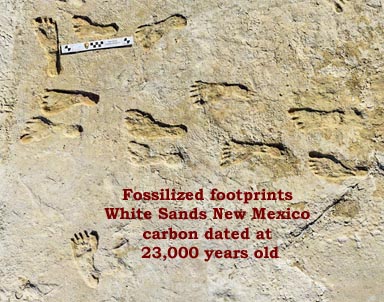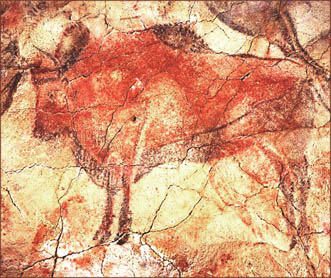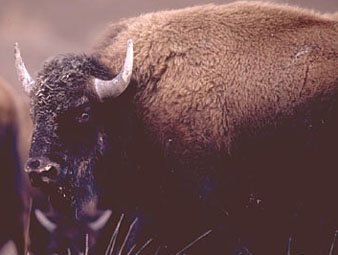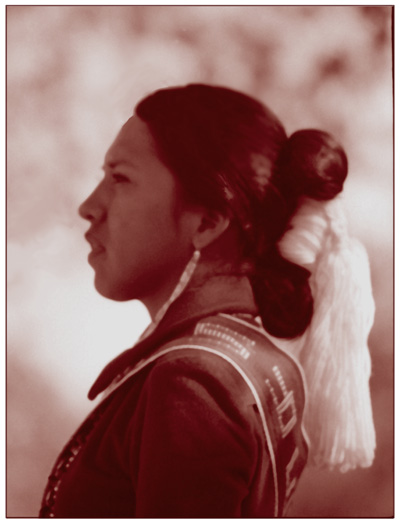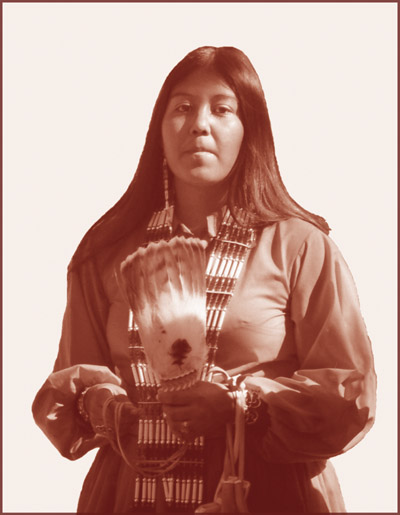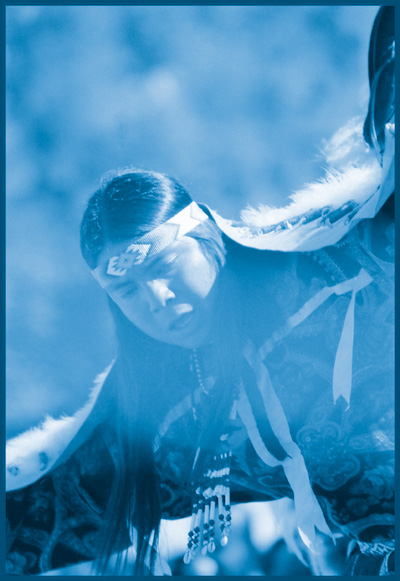Constance Holden suggests that Spaniards may have been among the first Americans, based on information at a meeting called "Clovis and Beyond," held (October 1999) in Santa Fe, New Mexico
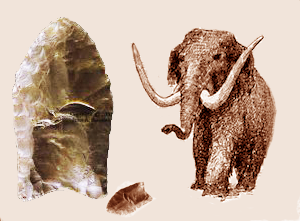
Stone Age Spanish (Solutrean) Ancestors Cowboys and Indians Are Family After All By Donald A. Chavez y Gilbert Our creator must have a BIG lesson here for us all. After all of these conflict-filled centuries of bigotry and war, the “us” versus “them” mantra needs serious reconsideration. Conventional wisdom about who the first Americans were has been turned on its ear. As modern forensic science becomes more reliable, the more compelling becomes the evidence that in America, our Stone Age Spanish (Solutrean) ancestors in fact arrived on the East coast thousands of years before our American Indian brothers arrived via the West coast. Some 3,500 years after the European Solutreans arrived and before anyone can remember, they became intimately acquainted with our Indian ancestors, and like wary in-laws of an ill-conceived marriage, consequently became the mutual grandparents of many of the first American cowboys (Spanish & Portuguese colonists) as well as many of the American Indian tribes. The conventional version of the first Americans, the “Clovis man,” the name attached to the American Indians who arrived here during the Big Ice Age over the Bering Straits (Bering Land Bridge) from Asia into Alaska and the rest of the Americas followed the route of the Clovis hypothesis, sites which are in the Southeastern US, the American west, ending up in Canada. The wooly mammoth skeleton with which it lay for 9,500 to 11,500 years dated the flint spearhead discovered at Clovis, New Mexico. That much, everyone still agrees, is correct. The date, however, was wrong by up to 20,000 years. With the advent of the decoded genome, scientists eliminated the concept of different human races because we humans are too closely related to be divided so arbitrarily. And now DNA science confirms the newly-revealed secret that our heretofore erstwhile first Americans are part Hispanic/Iberian European because when they (Indians) arrived in America they encountered the actual first Americans, (Europeans) who had already been here better than three thousand years. These first and second Americans apparently got along so well that they interbred into a larger Indian melting pot and were forgotten until now. In the alternative, the Indians, in an ironic twist of fate, decimated the first Americans and absorbed the women and children into their tribes, producing offspring with their captives. The flint spearhead discovered at Clovis, New Mexico was distinctive because it had two faces where stone flakes had been chipped (“knapped”) away from the flint core. This distinction was noticed in similar reports from forty-eight states, all dating to the same period. Whoever and wherever these incomers were from during this period, the introduction of this spear point was so effective that it coincided with the mass extinction of many of our continent’s prehistoric animals- including the first two North American horse subspecies, Equs Caballus Alaskae, the Beringian Horse, and Equs Caballus Mexicanus, the American Perigalcial Horse, as well as other native species such as the giant sloth, wooly mammoth, giant armadillo, and great black bear. All disappeared soon after the Clovis hunters (Indians) arrived on the scene. In 1977, archeologist Tom Dillehay of the University of Kentucky began excavating a site deep in the Chilean hills called Monte Verde. This human habitat was inhabited 12,500 years ago- a thousand years before the American Indians’ arrival from across the Bering Strait. In the United States, Jim Adavasio of Mercyhurst College, Pennsylvania dared to excavate below the Clovis layer at his dig near Pittsburgh, Pennsylvania, where he too found blades dating further back- all the way to 16,000BC. Predictably, there were too many archeologists’ reputations and oral Indian histories predicated on the American Indian Clovis man to make Dillehay and Adavasio’s discovery a smooth one. Both the status quo archeological community and conventional Indian authorities declared their findings incredible and erroneous. Decisive evidence would have to be independently validated. Dr. Douglas C. Wallace, Director, Center for Molecular & Mitochondrial Medicine and Genetics, Biological Chemistry, School of Medicine, University of California who studies the mitochondrial DNA, the part of human chromosomes that is passed unchanged from mother to daughter, a technique that has allowed Wallace to map the geographical ancestry of all the Native American peoples back to Siberia and northeast Asia. Wallace's migration history showed waves of incomers dating back twenty to thirty thousand years ago. Consequently the Clovis people (Indians) could clearly not be the first humans to set foot across North America. Further validation comes from Archaeologist Bruce Bradley, PhD, who specializes in the particular skill of reading flint knapping and flint tools for their most intimate secrets. He spotted the similarity in production method between the Clovis point and tools made by the Solutrean Neolithic (Stone Age) culture in European Iberia (Spain) and southwest France. According to Dr. Bradley, “the Solutreans were a remarkable society, the most innovative and adaptive of the time. They were among the first to discover the value of heat-treating flints to increase strength.” More evidence surfaced at an archaeological dig in Cactus Hill, Virginia, where Bradley determined that the Solutrean flint methods evolved into Clovis technology. To get past Dr. Bradley’s circumstantial evidence, Dr. Wallace profiled the DNA of the Ichigua Native American tribe and identified a European lineage that predated any genetic mixing after Columbus’s arrival in the new world. It dated back to the Solutrean peoples who made multiple migrations from Europe to America via the Atlantic coastline. Dennis Stanford of the Smithsonian Institution suggests how the Solutreans made the trek from Europe to America. “Ice-loving walrus could only have reached the American Chesapeake during the height of the Big Ice Age 15,000 to 20,000 years ago. Like the owner of the fossil walrus jaw found nearby, the Solutreans traversed their boats along the ice edge which bridged across the Atlantic Ocean at that time.” Unexpected benefits occurred as a result of a 1990 federal law, championed by Native American tribes, which requires museums to return Native American remains to their tribes. It forced the experts to sort out each of over 2,000 human relic profiles. A massive craniometric database was established with ninety skull measurements. This database made the distinctions between differing tribes, for example between Keres and Tiwa Indians groups, relatively straightforward. But as Sharon Begley and Andrew Murr put it, “some skulls stand out like pale-skinned, redheaded cousins at a family reunion of olive-skinned brunettes.” Begley and Murr and a growing number of published scientists’ new archeological digs, old bones, and DNA tests reveal an ancient American land that was a mosaic of peoples- including Asians and Europeans. “Consistently emerging evidence indicates that they were not Asians of Mongoloid stock who crossed a land bridge into Alaska 11,500 years ago, as our school textbooks say, but different ethnic groups, from places very different from what scientists thought even a few years ago. What's more, stone tools, hearths, and remains of dwellings unearthed from South Carolina to Peru suggest that Stone Age America was a crowded place for an America that was supposed to be empty until the Asians followed the coastline from Siberia into Alaska. A far different chronicle of the First Americans is therefore emerging from the clash of theories and discoveries that one anthropologist calls "skull wars." According to the evidence of stones and bones, America was populated by a wide variety of ethnic types, from southern Asia, East Asia and even Ice Age Europeans, who may have hugged the ice sheets in their animal-skin boats to reach America 3,500 years before Mongoloid American Indians. "It's very clear to me," says anthropologist Dennis Stanford of the Smithsonian Institution, "that we are looking at multiple migrations through a very long time period—migrations of many different peoples of many different ethnic origins." Constance Holden suggests that Spaniards may have been among the first Americans, based on information at a meeting called "Clovis and Beyond," held (October 1999) in Santa Fe, New Mexico, where archaeologists presented evidence of technological parallels between the Clovis people, (American Indians) - long thought to have been the first to settle in North America some 11,500 years ago - and the Solutreans, who lived in northern Spain some 20,000 years ago. Ancient paintings by Spanish Solutreans’ early experiences with livestock appear in the cave at Altamira, Spain near Santillana del Mar, Cantabria, in northern Spain. The drawings show bison, horses, raindeer and boar. So it is with no small degree of irony that these European Solutreans of Iberia, who developed and specialized the technology of the cowboy and ranching culture, the great-grandparents of ethnic Spanish and Portuguese explorers and colonizers of the Americas, are the same ancestors of the actual first Americans, having arrived in America from the Atlantic coast side during the Big Ice Age thousands of years before the ethnic Mongoloid Native American Indians who arrived from the Pacific coast line. Only an avid student of history, having studied and scoured the literature, would be able to hearken to the heretofore hidden voices between the pages along with those of a few still living elders who insisted that the vast majority of early Spanish and Indian peoples coexisted cooperatively and in peace over several hundred years following Columbus’ arrival in the Americas. Fame and glory, however, are ascribed to the negative dramatic “ratings gathering” side, that of conflict, strife and pain of loss. The conflict gets the play in the media and Hollywood. This limelight of conflict however, begins to be diminished under the scientific perspective that, indeed, these first American Solutreans as well as other incomers who preceded the ethnic Mongoloid American Indians coexisted well enough to have joined cultures and hunting technology and produced children together, leaving their shared legacy concealed in their genes until now. The final irony is that amid the mountains of circumstantial proof that Europeans preceded Indians in America, likened to the standards of evidence in our courts, there is a preponderance of evidence supporting this conclusion. The final, definitive piece of evidence flowing unchanged over the millennia pursued each consecutive generation like a long continuous chain in the genes of the Indians whose DNA exposed the inescapable revelation that the Solutreans were indeed here in the beginning, beyond a shadow of a doubt, the first Americans. Like it or not, we European Cowboys and Mongoloid Indians are family. The family ties that began 11,000 years ago were resumed in the fifteenth century with the return of Columbus and the Spanish colonists. So it behooves us to celebrate our likenesses rather than our differences, because there is no reasonable path back to the “us” versus “them” mantra. We are family after all, the way the creator intended.
